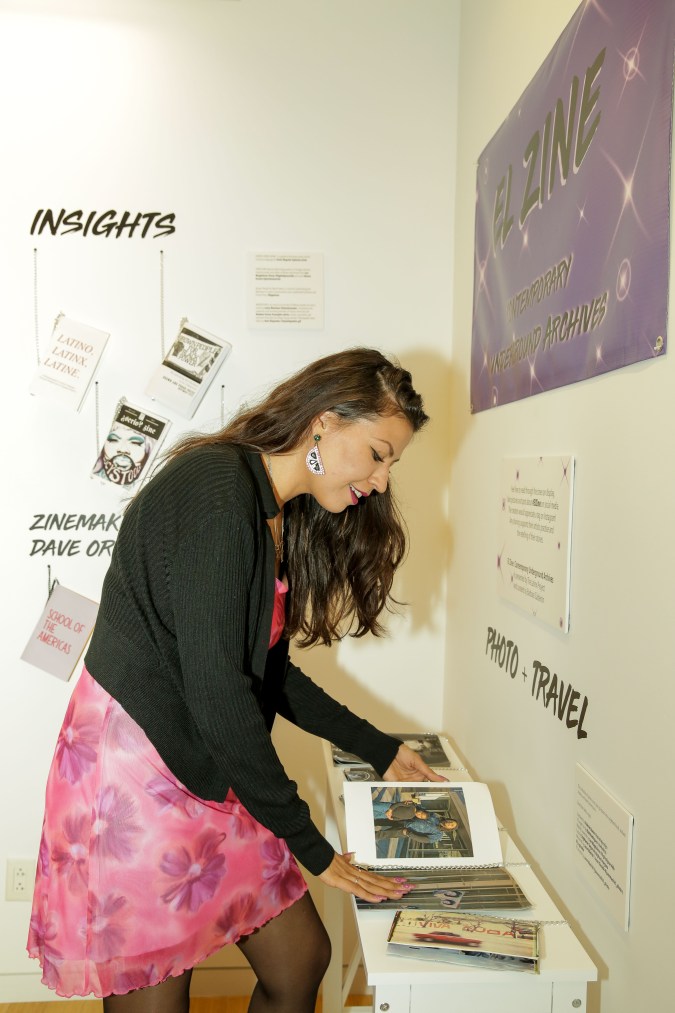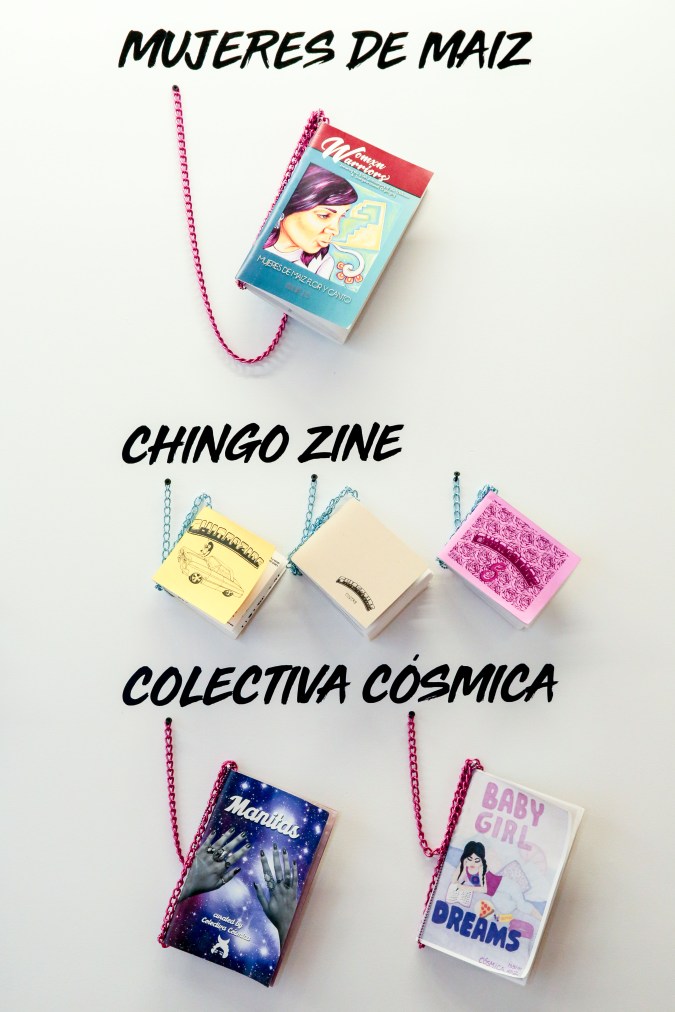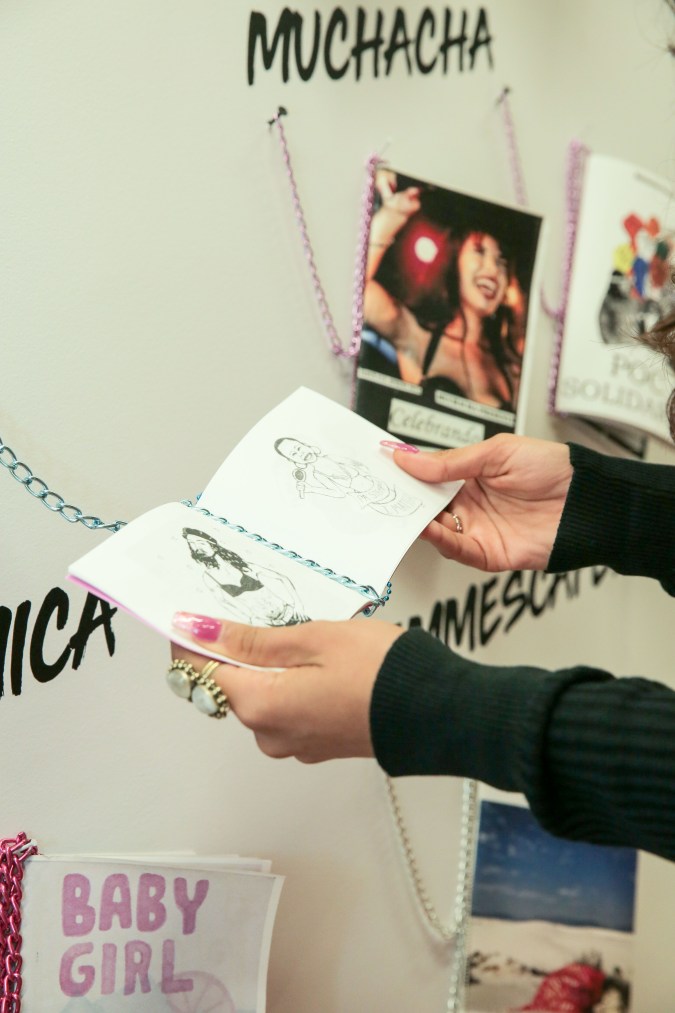Broadly speaking, zines are usually small, self-made publications printed in modest quantities by DIY artists and creatives. But the space offered in the pages of zines can feel boundless — particularly for underrepresented Latino individuals whose stories aren’t always reflected in mainstream spheres.
“Zines offer a way to create community.”
Barbara Calderón, a New York City-based artist, writer and curator, wanted to highlight the vast worlds that live within zines in the exhibition El Zine: Contemporary Underground Archives, which she organized as part of New York University’s Latinx Project. The show, on display on the fourth floor of 20 Cooper Square until Dec. 10, invites audiences to thumb through more than 50 zines created by 30-plus Latino artists, writers and illustrators, many of whom have been working and publishing content for decades under the radar.
Calderón has been an avid zine collector for a while now. She got started in 2014, after she helped form the arts collective Colectiva Cósmica, which hosts workshops and events and organizes in Latino communities in New York and Texas. The members of Colectiva Cósmica began releasing their own zines, which they would share at art fairs and panels across the country. It was through these travels that Calderón got to know zine-makers who were rejecting the traditional rules of publishing and content creation to foster their own spaces.

“Even if an idea hasn’t been fully flushed out, you can get feedback, and if people like what you’re doing, you can collaborate,” Calderón tells Remezcla. “Zines offer a way to create community, which is so necessary to growing and having the guts to put your work out there. If you see other people self-publishing, being creative and showing work, you’re more likely to do it yourself.”

Latina feminist collectives have contributed to zine culture.
Calderón would pick up zines whenever and wherever she could and, pretty soon, she had a massive assortment. She actually drew heavily upon her own collection for El Zine. She wanted the exhibition to highlight how zine culture has flourished in the last ten years, while also providing a nuanced look at the breadth of zines being made today. The show opened on Sept. 17 with a range of DIY publications that explore sex work, ancestral curanderismo and healing practices, queer and trans identity, and Afro-Latino experiences.
Nearly all of the zines hang from the wall or sit on surfaces so that anyone can actually flip through them. They’re organized by topics, which include advice and guidance, photo and travel, and personal insight. Calderón also wanted to highlight a handful of individual zine-makers to underscore the breadth of their work and their commitment to carving out their own spaces. She features zine-makers like Dave Ortega, who brings forgotten or little-known historical events to life with his own comics and illustrations, and Julia Arredondo, a Tejana artist behind zines that double as guides to punk alternative living (she also powers the independent publishing entities Curandera Press and Vice Versa Press).

It was also important to Calderón to emphasize how Latina feminist collectives have contributed to zine culture. In addition to a few zine selections from Colectiva Cósmica, the show includes collectives that have pushed zines forward, among them Chicago’s Brown and Proud Press, Austin’s Chingo Zine and L.A.’s Mujeres De Maiz.

“This is obviously not a new phenomenon. It’s been happening for decades, and it has a long lineage in punk DIY culture and also early feminist movements — even beyond that, if you think about revolutionary publications and pamphlets,” Calderón says. “But in the last couple of years, there has been a much larger push in the proliferation of zines, and I think it’s because of the work of collectives, particularly Latina feminist collectives.”

While the exhibition shines a giant spotlight on zines, it’s also a testament to the rich subcultures filled with Latino creators working at an independent level. For Calderón, it’s especially important that mainstream organizations take note of just how much creativity is brewing in Latino spaces, especially when questions of inadequate representation surface in the cultural conversation.
El Zine is a huge middle finger to that kind of narrow-minded thinking.
“When companies get called out for not having enough representation or doing something that’s f**ked up because they don’t have any Latinos at the table, the No. 1 thing that they always say is, ‘Well, we looked for a diverse candidates, we want to have diversity, but where are they? We couldn’t find them; it’s so hard to find these applicants of diverse backgrounds, ’” she says.

El Zine is a huge middle finger to that kind of narrow-minded thinking.
“I think that’s such bulls**t,” Calderón says. “That’s why I want this [exhibition] to function as a moment of, ‘Whoa whoa — there are so many amazing creatives that exist across the country.’ Maybe they’re not mainstream, but a lot of us are doing work in our own ways. It’s just that people aren’t looking in the right places for interesting, new, different creative people who could potentially populate art and culture spaces across the board.”
Editor’s note: Barbara Calderón has contributed to Remezcla in the past.




